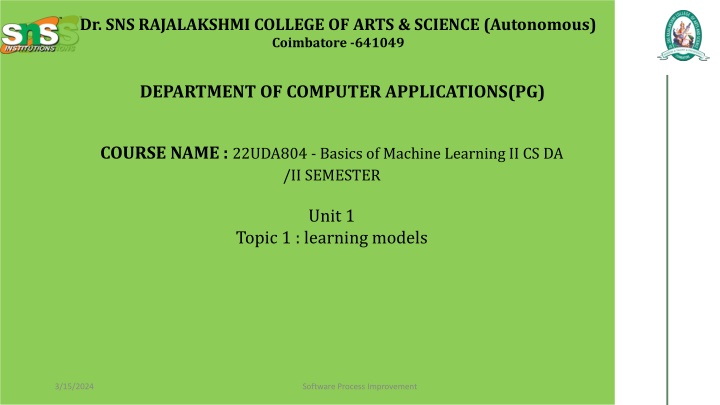
Types of Learning Models in Machine Learning
Explore the different types of learning models in machine learning, including supervised, unsupervised, and reinforcement learning models. Discover how these models are used in various applications such as spam detection, medical diagnosis, and more. Gain insights into the goals and examples of each type of model to enhance your understanding of machine learning concepts.
Download Presentation

Please find below an Image/Link to download the presentation.
The content on the website is provided AS IS for your information and personal use only. It may not be sold, licensed, or shared on other websites without obtaining consent from the author. If you encounter any issues during the download, it is possible that the publisher has removed the file from their server.
You are allowed to download the files provided on this website for personal or commercial use, subject to the condition that they are used lawfully. All files are the property of their respective owners.
The content on the website is provided AS IS for your information and personal use only. It may not be sold, licensed, or shared on other websites without obtaining consent from the author.
E N D
Presentation Transcript
Dr. SNS RAJALAKSHMI COLLEGE OF ARTS & SCIENCE (Autonomous) Coimbatore -641049 DEPARTMENT OF COMPUTER APPLICATIONS(PG) COURSE NAME : 22UDA804 - Basics of Machine Learning II CS DA /II SEMESTER Unit 1 Topic 1 : learning models 3/15/2024 Software Process Improvement
learning models Types of Learning Models in Machine Learning Machine Learning (ML) models are broadly categorized based on how they learn from data. The main types of learning models are: AWS FUNDAMENTALS
learning models . Supervised Learning Models Definition: The model is trained on labeled data, meaning each input has a corresponding correct output. Goal: Learn the mapping from inputs (features) to outputs (labels). Examples: Regression (Predicting continuous values) Linear Regression Decision Trees (for regression) Classification (Predicting categories) Logistic Regression Support Vector Machines (SVM) : AWS FUNDAMENTALS
learning models Neural Networks Random Forest Applications: Spam detection, medical diagnosis, stock price prediction AWS FUNDAMENTALS
learning models 2. Unsupervised Learning Models Definition: The model is trained on unlabeled data and must find patterns or structures in the data. Goal: Discover hidden structures and relationships without predefined labels. Examples: Clustering (Grouping similar data) K-Means Clustering Hierarchical Clustering DBSCAN Dimensionality Reduction (Reducing data complexity) Principal Component Analysis (PCA) t-SNE (t-distributed Stochastic Neighbor Embedding) AWS FUNDAMENTALS Applications: Customer segmentation, anomaly detection, recommendation systems
learning models 3. Semi-Supervised Learning Models Definition: Uses a mix of labeled and unlabeled data to improve learning. Goal: Leverage small amounts of labeled data and a large amount of unlabeled data to improve model performance. Examples: Self-training models Graph-based semi-supervised learning Applications: Image recognition, medical diagnosis, speech recognition AWS FUNDAMENTALS
learning models 4. Reinforcement Learning Models Definition: The model learns through trial and error by interacting with an environment and receiving rewards or penalties. Goal: Maximize cumulative rewards over time. Key Concepts: Agent: The learner making decisions Environment: The world the agent interacts with Actions: Possible decisions the agent can take Rewards: Feedback received for each action AWS FUNDAMENTALS
learning models Examples: Q-Learning Deep Q-Networks (DQN) Proximal Policy Optimization (PPO) Deep Deterministic Policy Gradient (DDPG) Applications: Robotics, game playing (AlphaGo, OpenAI Gym), autonomous driving AWS FUNDAMENTALS
learning models AWS FUNDAMENTALS
